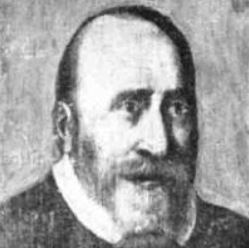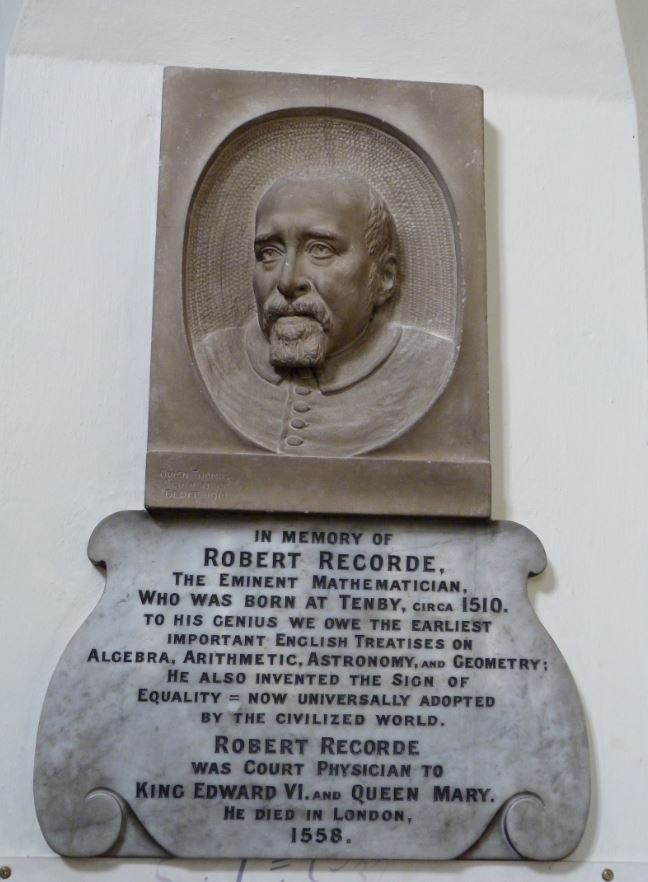It All Adds Up
Zenzizenzizenic

You know about Robert Recorde’s invention. Of course you do. Everyone does. You have used it, perhaps even on a daily basis. It is just that no one has told you it was him. But it was.
This story begins in St Mary’s Church in Tenby. It is a very attractive place in the heart of the walled town, a place of memorials and the perfect place for a wander. Inside there is an excellent classically-inspired sculpture to Captain Bird Allen who died in 1841 on an expedition to help suppress the slave trade in Africa. He wrote in a letter home that ‘it has pleased the Almighty to lay his hand upon us with the chastisement of sickness.’ His memorial puts it more succinctly though, when it says that he fell victim ‘to the climate of the river Niger.’ You can also see one of my favourite memorial tablets in the whole of Wales, the one to Peggy Davies. It had been written with considerable affection for a woman who, for 42 years, had attended visiting ladies who came to Tenby for fashionable sea-bathing. On 29 September 1809 ‘in the water she was seized with apoplexy and expired, aged 82.’ Interesting though these stories are neither of them is the reason why we are looking at St Mary’s. There is another notable memorial, that to the remarkable Robert Recorde.

He was born in Tenby, probably in 1510, and is perhaps the greatest of all Welsh scholars, for he was the man who drew two short parallel lines and so invented = , the equals sign. There are no pictures of him, which is a shame because Robert Recorde has touched the lives of everyone, even if they don’t realise it. There is this memorial of course in the church but the only existing picture of him, on which the carving in the church is modelled, is probably not a likeness of him at all. Of course he was born such a long time ago that much of his life equals a mystery and there is a great deal that we don’t know. I can tell you that his father Thomas was Lord Mayor of Tenby and that Robert was destined for an academic career. He went to Oxford University, possibly to study medicine and graduated in 1531. He was certainly a highly educated man with a wide range of interests which encompassed the Anglo Saxon language and history. He seems to have been a teacher of mathematics and to have spent some time at Cambridge University too, where he was recognised as a Doctor of Medicine, an area of knowledge which included astrology and cosmology. Soon he went to practise medicine in London. In 1547 Henry VIII died and was succeeded by ten-year old Edward VI. In the same year Recorde’s work The Urinal of Physick was published, an essential text that explored how you could diagnose illness from the condition of a patient’s urine. It established him as a prominent medical figure. We can see this because he was asked to assess the mental condition of someone imprisoned in the Tower of London who had been charged with claiming to be a false prophet. He probably went on to practise as a physician in Edward’s court and he had certainly established himself there by 1549, when he moved into the Civil Service, becoming Controller of the Royal Mint in Bristol and of the new London mint on the Strand. He was responsible for the introduction of the first silver crown to have the date in Arabic rather than Roman numerals. But this was not a job without its dangers. The previous incumbent in Bristol had been sent to the Tower, and whilst Recorde was a highly intelligent man, his skills did not equip him for the uncertainty of the times in which he lived. He got himself into particular difficulties with Sir William Herbert who was an influential figure and a governor of the young King Edward. He was active in suppressing unrest in parts of the country and requested money to fund his army to carry that out.
Recorde however refused, since the request did not come from the King. In response, Herbert closed the Bristol mint and Recorde was confined to the court for sixty days having made himself a dangerous enemy. He was sufficiently rehabilitated by 1551 when he was appointed as Controller of Mines and Money in Ireland, with responsibility for the silver mines in Wexford and the Dublin mint. Recorde was a loyal protestant but when the regime changed in 1553 with Queen Mary’s accession Herbert was rewarded for his loyal support of the new Catholic Queen with the title of Earl of Pembroke and with a position as a Privy councillor. Recorde found himself on the wrong side of the political divide. They clashed again in a dispute about mining in Wexford and smelting rights at Pentyrch, near Cardiff, and Pembroke recalled Recorde from Ireland. This was devious Tudor politics, nothing more than that, but Robert Recorde became one of its victims. He foolishly accused Pembroke of misconduct and in response Pembroke sued Recorde for libel in October 1556. This was a significant mistake. Robert Recorde was out of his depth and was told to pay £1000 in damages which was exactly the amount he was owed for his work in Ireland but which hadn’t been paid. He did not have the money and was then imprisoned in Southwark where he died in 1558. His will included small legacies for nine children – each one of them a record holder in their own way. Ironically in 1570 his estate was finally awarded that £1000 – twelve years after his death It is for his maths that we remember him today, including his book The Pathway to Knowledge from 1551 which is about geometry. If I am honest it would be fair to say that for me geometry has never been anything other than an over-grown, barely trodden track leading absolutely nowhere but Robert Recorde clearly felt rather differently. He also wrote The Castle of Knowledge about astronomy and The Treasure of Knowledge. He clearly had no time for modest titles. His books are generally in the form of a dialogue between master and servant. Now I have read extracts from them and all I can say is that if I had been the servant, then Mr Recorde would have had to speak a great deal more slowly. The important thing though is that these books were not written in Latin but in English, and were intended to be simple and accessible for ordinary people, the same principles which underpinned the earliest book on childcare in English, written by Thomas Phaer in 1545, who lived in Cilgerran on the north side of Pembrokeshire. The title of his volume, The Whetstone of Witte from 1557, suggests that it is a book by which you can sharpen your mathematical understanding and through it he established his lasting fame. It is a teaching manual for an advanced mathematical course in which he introduced the plus and minus signs already in use in Germany, but his greatest success was the equals sign. Recorde got fed up with writing ‘is equal to’ and designed the new symbol because, as he said, he could think of nothing more equal than two parallel lines of the same length. I imagine you cannot either. Recorde invented some other English mathematical terms which I am disappointed to say did not catch on – like ‘cinkangle’ for pentagon, and ‘siseangle’ for hexagon. But I think his triumph was the invention of a term which sounds like the name of a green-skinned galactic tyrant in a cheap 1950’s science fiction film. He described a number raised to the eighth power as a zenzizenzizenic and went on to explain that ‘it doth represent the square of squares squaredly.’ I couldn’t put it better myself.
Robert Recorde. Tenby’s son. Tenby’s pride.
This story features in my new book, Grave Tales from Wales Volume Two, published in April 2022. In it, there are 35 other fascinating gravestones from across the whole of Wales.
Find Grave Tales From Wales in the menu or follow this link
Alternatively, go straight to the How To Buy Page